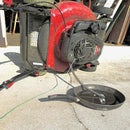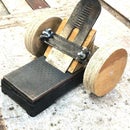Introduction: Triangular to Square Tap Adapter
Earlier I did an Instructable on a thread Tapping Fixture for a Drill Press. The tap too easily slipped in the 3-jaw chuck on the drill press. I could buy commercially produced adapters, but they seem a little expensive. This Instructable will show a way to make your own.
Materials
- 1/2 inch steel rod
Tools
- Hacksaw
- Grinder
- Drill press and twist drills
- Miniature file (triangular)
The photo shows the adapter I made. It has a square socket for the end of my 1/4 x 20 tap. It also has three flats to fit the 1/2 inch chuck on my drill press.
Step 1: Saw the Steel Rod to Length
I cut about 1 inch from a piece of 1/2 inch steel rod. That is enough to catch and hold the square end of the tap and to keep the tap in alignment when being used in the drill chuck.
Step 2: Mark for the Three Flats
I put the piece of rod I cut into the drill chuck and made marks with a felt tip pen that align with the three chuck wrench holes.
Step 3: Grind Flats
I placed the marked piece of rod into my vise and used a hand-held grinder to grind a flat where each mark is. I ground just a little and checked to be sure my ground flat was centered on the mark as much as possible. I also tried to watch that the ground flat has parallel sides, not keystoned sides.
Step 4: Set the Hole Depth
This tap is a strong 1/4 inch in diameter. I had to use a twist drill that is a few thousandths of an inch over 1/4 inch in order for the tap to slide into the hole drilled up the center of the rod for it. I used masking tape to mark the desired depth, but it moved while I was drilling. A collar with a setscrew would be better.
Step 5: Drilling
I drilled up from the bottom of the rod to pass the round shank of the tap, but stopped to leave an amount equal to the square end's length. Then I changed twist drills and used a smaller one equal in diameter to the thickness between two flats on the tap's square end.
Step 6: File to Fit
I used a miniature triangular file to file the smaller hole so it makes a square socket for the square end of the tap. It is just a matter for a little filing by hand followed by checking the fit. It takes a little time and care, but works out pretty well.
Step 7: Use the Tap Adapter
Now I can put my tap and adapter into the drill press chuck. I can add the handle I made for turning the chuck. See the earlier Instructable. The tap will not slip in the chuck now. (See the link to that Instructable in the Introduction to this Instructable.)
At the present my tap can fall out of the adapter. I can use some tape to hold it. Also, 1/4 x 20 threads are the most common I make, but I will need to make a new adapter for any other tap sizes I want to use. If the socket hole is too small to receive a file, I may have to use a setscrew to keep the tap from slipping.











